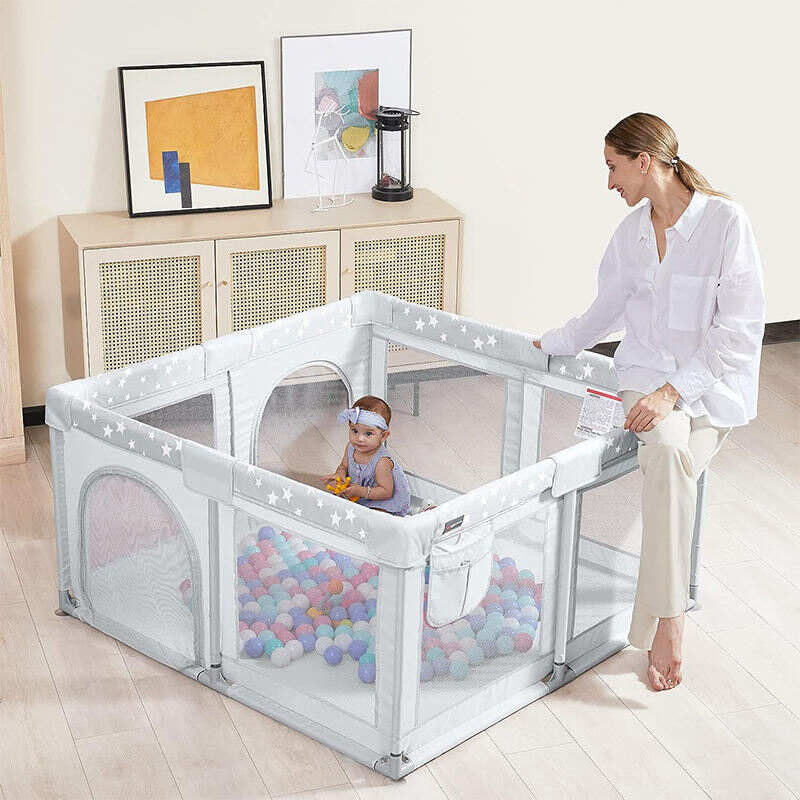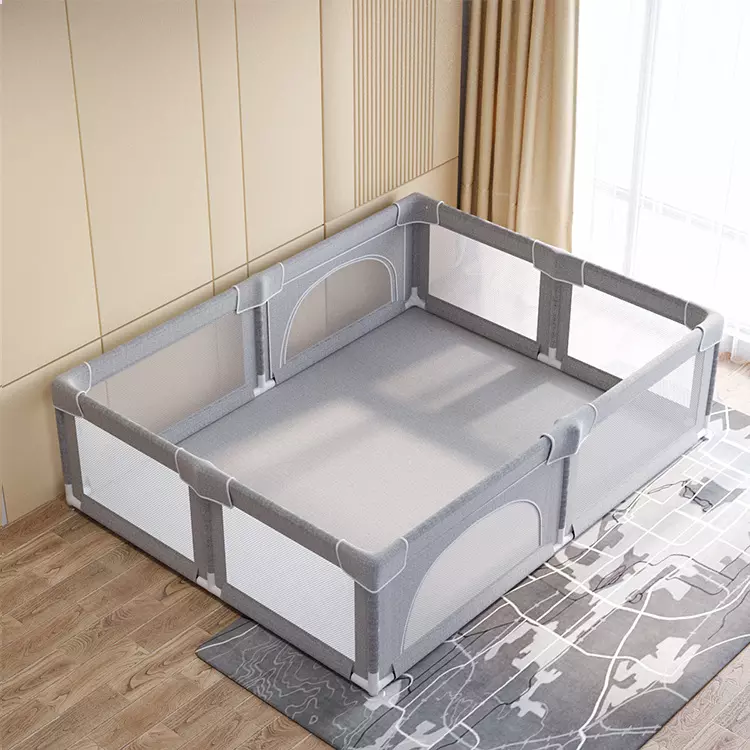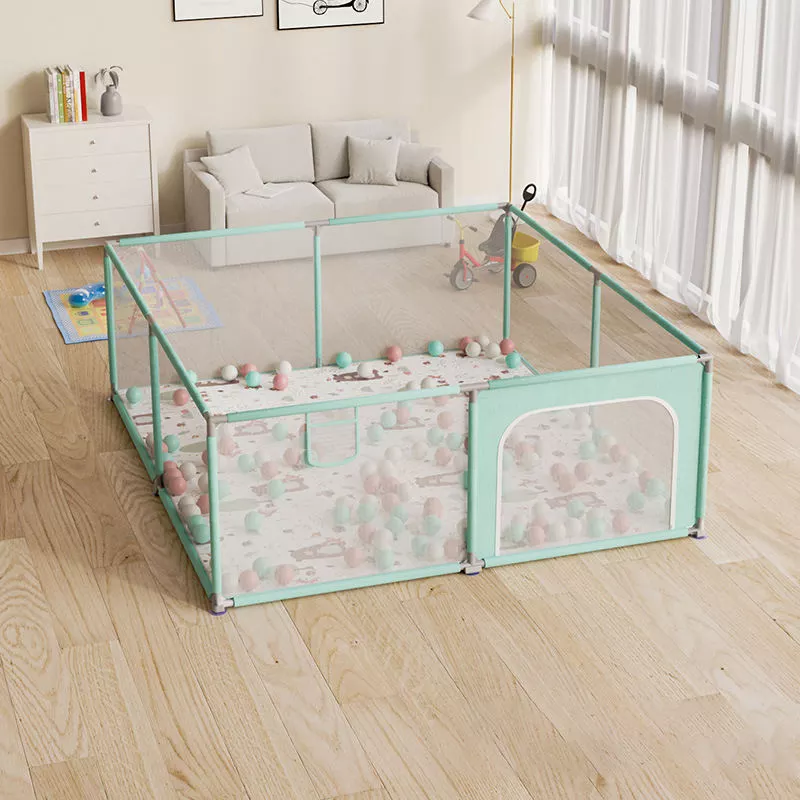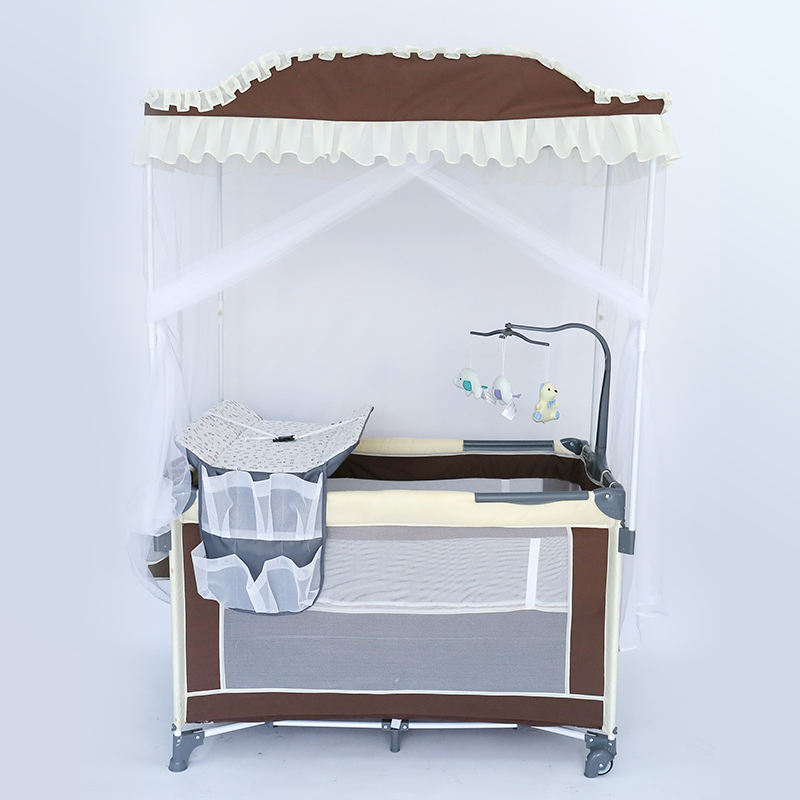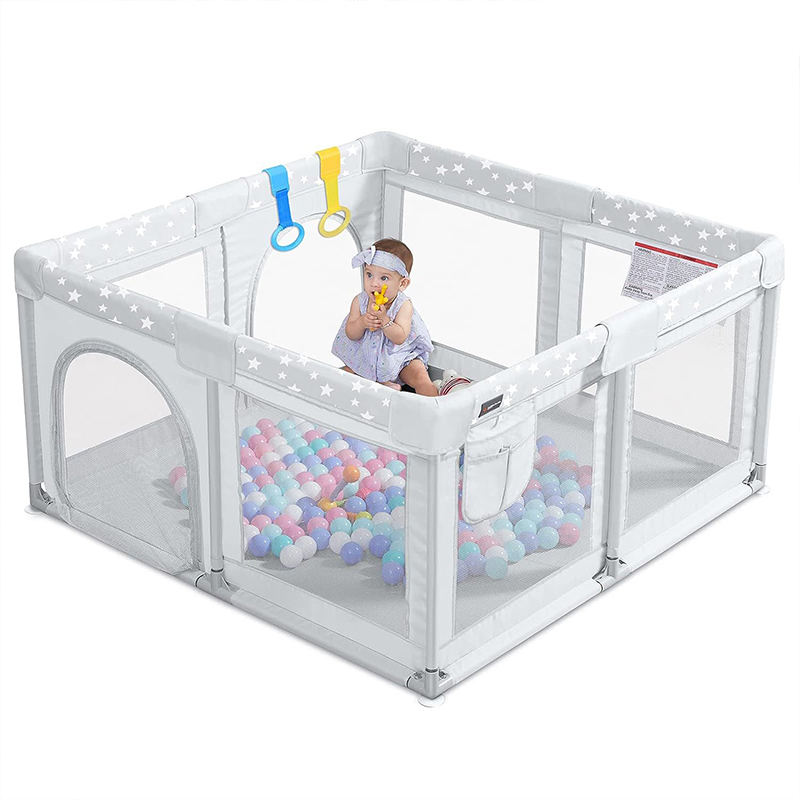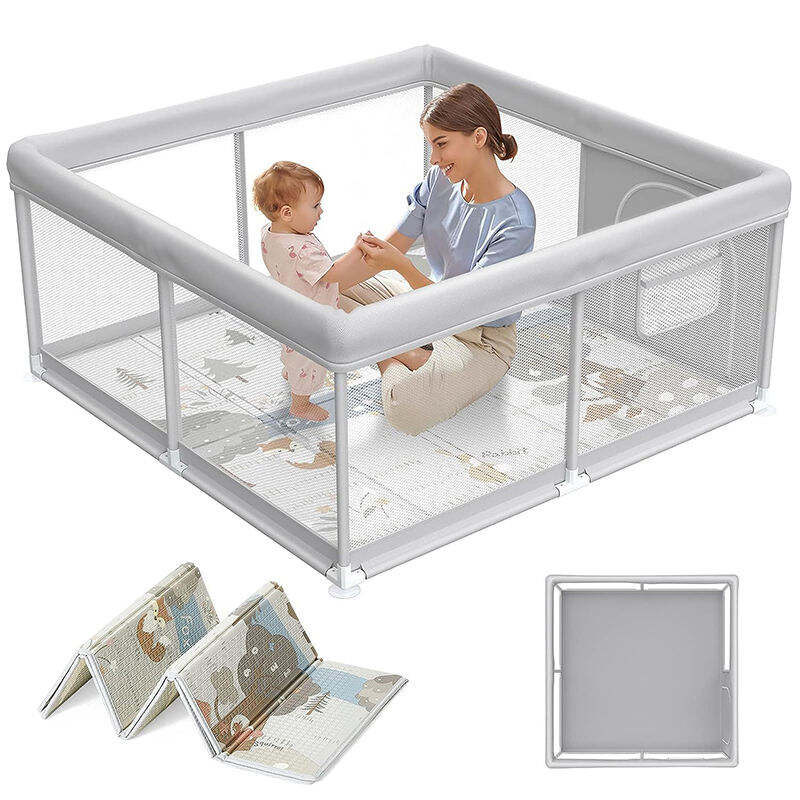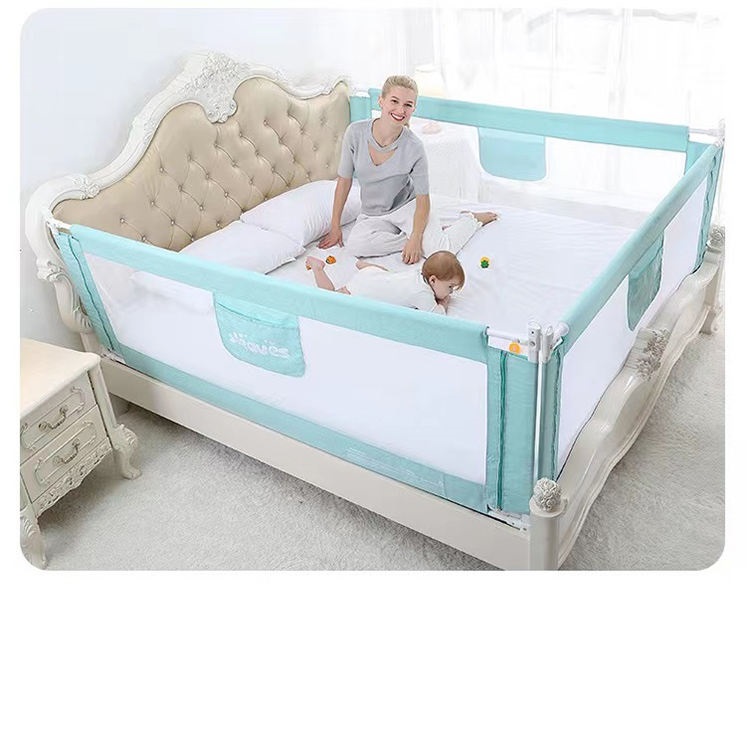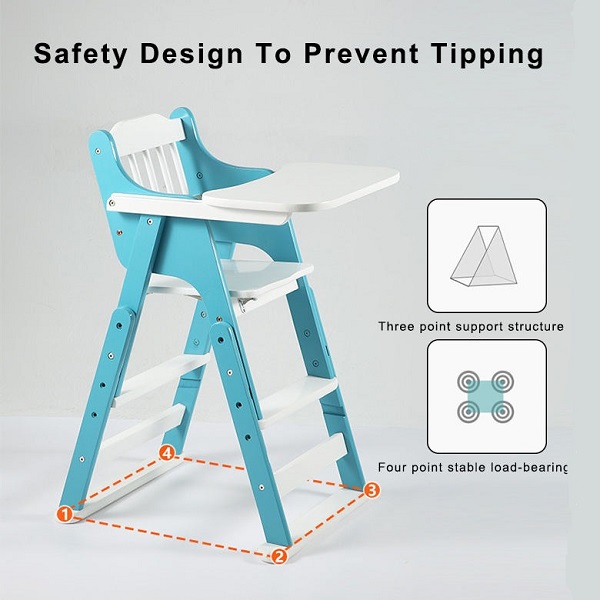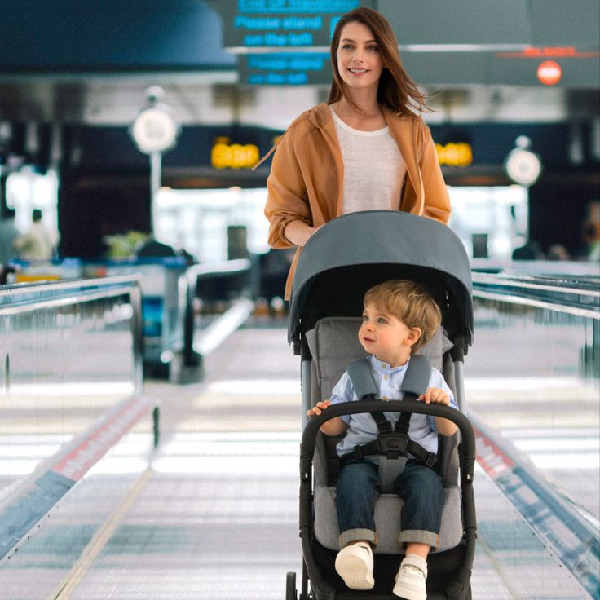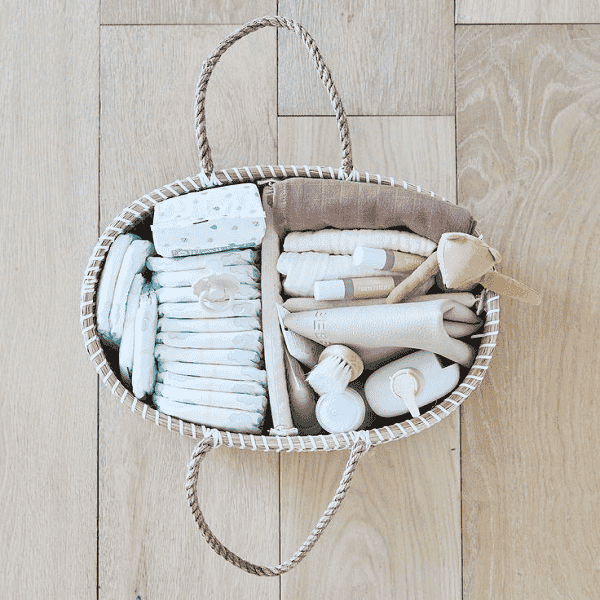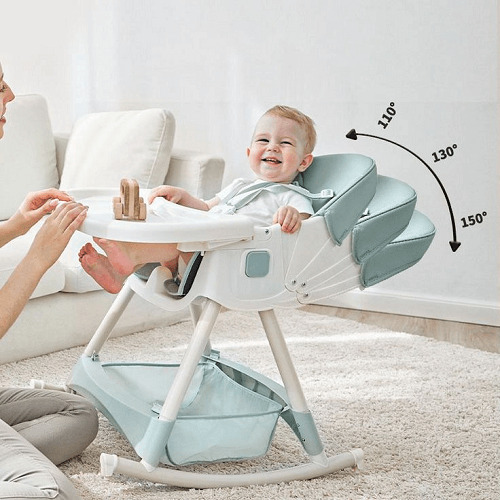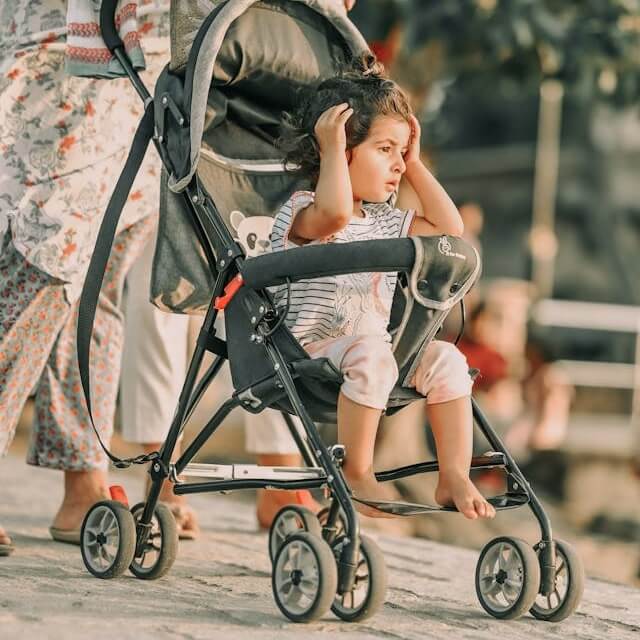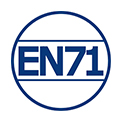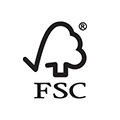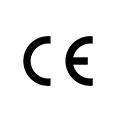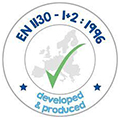A baby playpen is a multi-purpose piece of equipment designed to keep your little ones safe while providing a fun environment for them to play and explore.
This comprehensive guide aims to delve into the nuances of baby playpens, addressing common questions, offering practical advice, and highlighting the top picks for 2024.
Are Playpens Good for Babies?
Yes, and the benefits are many!
1. Designate a Safe Space for Your Baby
Playpens offer a secure space where infants can play, explore, and develop their motor skills without the constant risk of harm. By establishing a designated area for play, parents can ensure their baby’s safety from household hazards while fostering an environment that encourages independent play.
2. Positive for the Baby’s Cognitive Development
Moreover, playpens are equipped with a variety of toys and educational materials. From colorful rattles to tactile fabrics, the playpen environment can be customized to cater to the developmental needs of each child, promoting visual, auditory, and kinesthetic learning.
3. Make it Easier for Parents to Look After Their Children
Importantly, playpens provide a practical solution for parents who need to balance household chores or work with child supervision. Imagine a typical day for a parent: there are dishes to be washed, laundry to be folded, and meals to be prepared, all while ensuring that the baby is safe and attended to. It is a very good idea to just put the child in the playpen at this time.
For instance, during meal preparation, a parent can place the playpen in the kitchen within their line of sight. While chopping vegetables or cooking on the stove, they can keep an eye on their baby playing safely in the playpen nearby. The baby remains content and engaged with toys or activities within reach, while the parent can focus on cooking without worrying about the baby’s safety.
Are Playpens Necessary?
While not every family may find an infant playpen indispensable, they undeniably offer an added layer of safety for children in homes where potential hazards cannot be completely eliminated.
If you have a better-designated area in your home for your child to play safely, or if you have enough manpower to watch your child around the clock, you don’t necessarily need to buy a playpen.
While they are not essential for every family, they can be valuable tools in certain situations. Here are some factors to consider when determining if a play yard is necessary for you:
1. Safety Concerns: Playards provide a confined and safe space for babies to play, nap, or rest. If you have safety concerns in your living environment, such as stairs, pets, or fragile items, a playard can offer peace of mind by creating a secure area for your baby.
2. Parental Needs: Play yards can be particularly useful for parents who need to balance household chores, work, or other responsibilities while supervising their baby.
3. Travel and Portability: Many playpens are designed to be portable, making them convenient for travel or visiting friends and family. If you frequently travel or need a safe place for your baby outside of the home, a play yard can be a practical investment.
4. Parental Preference: Some parents may find that their baby prefers playing in an open area or that they are comfortable supervising their baby without the need for a play yard. Others may appreciate the structure and containment that a play yard offers.
Top Baby Playpens of 2024
1. Foldable Playpen
Designed with portability and ease of use in mind, this foldable design allows for effortless storage and transportation, making it ideal for travel or visiting friends and family. The designer took into account the busyness and tight space of modern parents when designing it. It can be easily folded in a few minutes and placed in a corner, under the bed, or on the sofa.
Product Features:
- Foldable design
- Sturdy construction
- The bottom has 8 suction cups with strong suction power
- There are 2 entrances for babies to enter and exit
- Breathable visible mesh
- Made of baby-safe material, no fluorescent agent
| Advantages | 1. Convenient for travel and storage 2. Easy to set up and fold down 3. Offers versatility for indoor and outdoor use 4. Durable construction ensures long-lasting use |
| Disadvantages | 1. May not be as spacious as non-foldable playpens 2. Lack of additional features like a bassinet or changing table |
| Applicable Scenarios | 1. Traveling with a baby 2. Visiting friends or family 3. Setting up a play area in small spaces4. Outdoor activities or picnics |
2. Square Large Baby Playpen
With its square shape and ample interior space, this large infant playpen provides plenty of room for babies to move around freely. The area is spacious enough to place a variety of interesting toys and allow your baby to engage in various activities, even for warm parent-child activities.
Product Features:
- Large size
- Stable suction cup design
- Height 65cm
- Spacious zipper door
- The material does not contain formaldehyde and is not afraid of babies chewing it.
- With side storage pockets
| Advantages | 1. Provides plenty of room for babies to play and explore 2. Durable construction ensures long-lasting use 3. A square shape allows for easy placement in various room configurations 4. Contains no harmful substances and protects your baby’s health 5. Storage bag conveniently stores snacks and toys |
Disadvantages | 1. May take up more space compared to smaller playpens 2. Assembly and disassembly may require additional effort |
| Applicable Scenarios | 1. Creating a play area in a spacious room 2. Outdoor playtime in the backyard or patio 3. Setting up a play area for multiple babies or siblings |
3. Playpen with Bassinet
Combining the functionality of a playpen with the convenience of a bassinet, this product provides a safe and comfortable sleep environment for newborns and infants. The bassinet attachment allows babies to sleep at a higher level, making it easier for parents to reach them for feeding or soothing during the night.
As the baby grows, the playard can be removed, transforming the playpen into a spacious play area for active play and exploration.
Product Features:
- With a detachable bassinet for newborns and infants
- Bassinet attachment with soft and comfortable mattress
- With breathable mosquito net
- With changing table
| Advantages | 1. Provides a comfortable sleep environment for infants 2. Allows for easy access to the baby for feeding or soothing during the night 3. Offers versatility as a playpen and bassinet in one product 4. Makes it easier to change your baby’s diapers 5. Keep children safe from mosquito bites 6. Convertible design saves money on purchasing multiple pieces of furniture 7. Easy to assemble and disassemble, saving time and energy |
Disadvantages | 1. May be heavier compared to standalone playpens 2. Bassinet attachment may have weight or age limitations |
| Applicable Scenarios | 1. Newborn sleep solution for parents who prefer a bassinet close to their bed 2. Creating a safe play area for babies during the day 3. Traveling with a baby who requires a portable sleep solution |
4. Portable Small Baby Playpen
The portable small baby playpen is designed for parents seeking a compact and lightweight solution for on-the-go use. Whether traveling, visiting friends or family, or simply moving between rooms at home, this playpen offers a convenient and secure space for babies to play and rest.
Its portable design allows for easy transport and storage, while its sturdy construction and safety features ensure peace of mind for parents.
Despite its small size, this playpen provides ample room for babies to play and explore, making it an ideal choice for parents with limited space or frequent travelers.
Product Features:
- Compact and lightweight design
- Collapsible design
- Made of 300D Oxford cloth
- With zippered door
- Built-in storage bag
| Advantages | 1. Portable design is ideal for travel or on-the-go use 2. Compact size is suitable for small spaces or apartments 3. Easy to set up and fold down for quick assembly and storage |
| Disadvantages | 1. May not provide as much room for babies to move around compared to larger playpens 2. Some models may lack additional features like a bassinet or changing table |
| Applicable Scenarios | 1. traveling with a baby 2. Visiting friends or family with a baby 3. Setting up a play area in small living spaces or apartments |
5. Large Play Yard with a Mat
With its generous size and included mat, this baby fence provides ample room for babies to crawl, roll, and play freely. The durable construction and safety features ensure a secure environment for babies, while the soft and cushioned mat provides a comfortable surface for playtime.
Product Features:
- Large play yard with ample interior space
- Comes with a cushion
- Use materials that are easy to clean
- Both the fence and the mat are foldable
- Versatile design for use indoors or outdoors
| Advantages | 1. Provides plenty of room for babies to play and explore 2. The included mat offers a soft and comfortable surface for playtime 3. Safety features provide peace of mind for parents 4. The material is easy to clean, keeping the fence clean and hygienic |
Disadvantages | 1. May take up more space 2 .ssembly and disassembly may require additional effort |
| Applicable Scenarios | 1. Creating a spacious play area in a living room or playroom 2. Outdoor playtime in the backyard or patio 3. Setting up a play area for multiple babies or siblings |
6. Modular Playpens

Modular playpens offer versatility and flexibility, allowing parents to customize the size and shape of the play area to fit their specific needs. With interchangeable panels, these playpens can be configured into various shapes, such as square, rectangle, or hexagon, to accommodate different room layouts or play preferences. The modular design also allows for easy expansion or contraction of the play area as needed.
Product Features:
- Has removable modules
- Made of safe materials
- Contains a safety locking mechanism
| Advantages | 1. Offers flexibility to customize the play area according to needs 2. Allow for easy expansion or contraction of the playpen 3. Durable construction ensures stability and safety 4. Safety features provide peace of mind for parents |
| Disadvantages | May take up more space |
| Applicable Scenarios | 1. Creating a customized play area to fit different room layouts 2. Setting up a play area for multiple babies or siblings with varying ages or needs |
7. Anti-Fall Bedside Baby Playpen
The anti-fall bedside baby playpen is designed to provide a safe and secure sleeping environment for infants while attached to the side of an adult bed.
This innovative design allows parents to keep their baby close for nighttime feeding, comforting, or monitoring while ensuring a separate and secure sleep space. With its sturdy construction and safety features, including mesh sides for airflow and visibility, this bedside playpen offers peace of mind for parents and a comfortable sleep environment for babies.
Its adjustable height and easy attachment make it a convenient solution for parents seeking a safe and practical sleep solution for their little ones.
Product Features:
- Vertical lifting does not take up space
- One hand to complete the operation
- The switch is outside to prevent accidental opening
- It can be raised to 95cm
- Independent connector, you can freely choose which side to lift
| Advantages | 1. Allows parents to keep their baby close for nighttime feeding or comforting 2. Adjustable height accommodates different bed heights 3. Mesh sides provide airflow and visibility for peace of mind 4. Easy attachment and detachment from the adult bed 5. Prevent baby from falling in bed |
Disadvantages | 1. May not be suitable for all bed types or sizes 2. Assembly and attachment may require additional effort 3. Not suitable for use on the ground or outside |
| Applicable Scenarios | 1. Nighttime feeding or comforting with a newborn or infant 2. Co-sleeping with a separate sleep space for the baby |
What Age Is Best for Playpen?
Generally, babies can start using a playpen fence safely once they are able to sit up independently, usually around 6 to 8 months of age. At this stage, they have better control over their movements and can engage in independent play within the confines of the playpen.
Introducing a playpen too early, before a baby has developed sufficient motor skills and strength to sit up, may not be as beneficial. Younger infants may not be able to fully enjoy or engage with the toys or activities in the playpen, and they may become frustrated or unhappy with being confined.
Conversely, waiting too long to introduce a playpen may also limit its effectiveness. As babies become more mobile and curious, they may require more supervision and may not be content to stay in one place for long periods.
If you find yourself needing a safe and contained space for your baby while you attend to household chores, work, or other tasks, introducing a playpen once your baby can sit up independently may be beneficial for both you and your baby.
How to Stop Baby Playpen from Moving?
Baby fences can move due to factors like smooth surfaces, baby’s movements, design, external factors, and worn parts. Therefore, the following measures can be taken to prevent:
1. Use Anti-Skid Pads or Grippers
Place anti-skid pads or grippers underneath the playpen’s legs. These rubber or adhesive pads provide traction and help prevent the playpen from sliding or shifting on smooth surfaces like hardwood floors or tiles.
2. Secure the Wheels
If your playpen comes with wheels, ensure that they are locked in place.
3. Use Weight
You can place heavy objects such as books, weighted bags, or exercise weights inside the playpen, particularly in the corners or at the base of the legs.
4. Anchor to the Wall
If the playpen has anchor points or loops for securing it to the wall, use safety straps or anchors to attach it firmly to the wall.
5. Place Against a Wall
Position the playpen against a wall or sturdy furniture to provide additional support and stability. This helps prevent the playpen from shifting or moving when your baby moves around inside.
6. Check for Level Surface
Ensure that the surface underneath the playpen is level and even. Adjust the position or placement of the playpen as needed to ensure it sits securely on a flat surface.
How to Clean Baby Playpen?
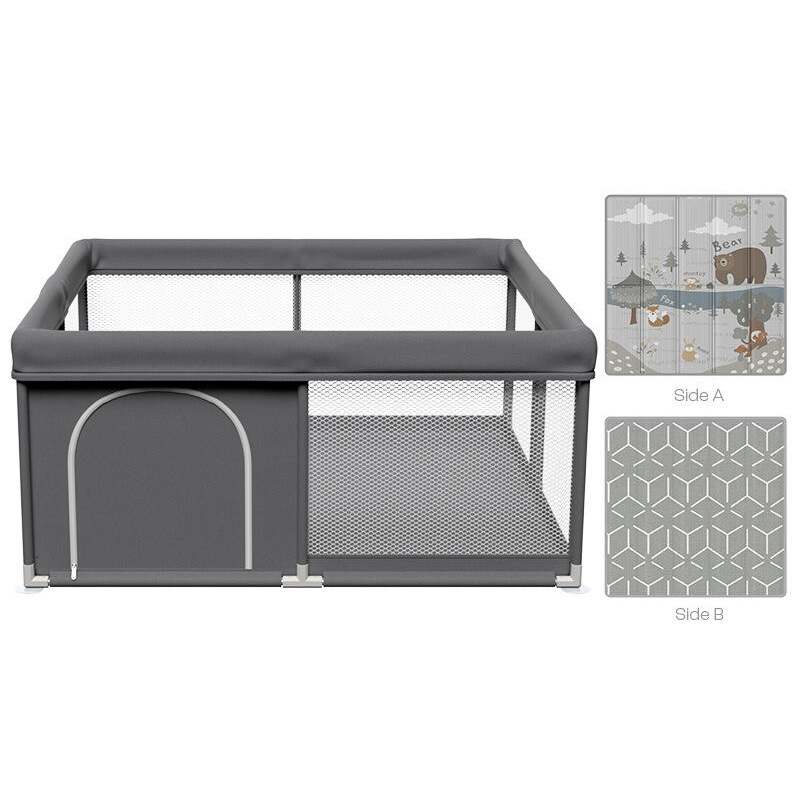
Maintaining a clean and hygienic play environment is paramount for a baby’s health. Establishing a routine cleaning schedule, including daily wipe-downs of surfaces with mild, baby-safe cleaners and weekly deep cleans, can prevent the buildup of dirt, bacteria, and allergens. When selecting cleaning products, it’s important to opt for non-toxic, fragrance-free options that are safe for use around babies.
To clean an infant playpen fence:
- Take out any toys, cushions, or other accessories from the playpen.
- Use a vacuum cleaner with a brush attachment to remove dust, crumbs, and debris from the playpen’s surface and crevices.
- Mix a small amount of mild dish soap with warm water in a bucket or basin. Dampen a clean cloth or sponge in the soapy water and gently wipe down the entire playpen, including the sides, bottom, and any mesh panels. Pay attention to areas with visible stains or spills.
- Use a separate clean cloth or sponge dampened with plain water to rinse off any soap residue from the playpen.
- Use a dry towel or allow the playpen to air dry completely before reassembling or using it again. Ensure that all parts are completely dry to prevent mold or mildew growth.
- For stubborn stains or sticky residue, use a gentle baby-safe stain remover or spot cleaner.
- If desired or if the playpen has been exposed to illness or contamination, you can disinfect it using a diluted bleach solution. Mix one part bleach with nine parts water in a spray bottle, then spray the solution onto the playpen surfaces. Allow it to sit for a few minutes, then wipe clean with a damp cloth and rinse thoroughly. Ensure that the playpen is completely dry before using it again.
- Once the playpen is clean and dry, reassemble any removable parts or accessories and place them back inside the playpen.
Can a Baby Sleep in a Playpen Every Night?
Child playpens are not designed with the same level of support and comfort as cribs or bassinets. They typically have thinner mattresses or padding, which may not provide adequate support for a baby’s developing spine and body during prolonged sleep.
Moreover, playpens for toddlers are not intended for unsupervised sleep, especially for extended periods. They may not meet the safety standards required for cribs, increasing the risk of suffocation, entrapment, or other sleep-related hazards.
While a playpen is a convenient option for occasional naps or travel, it’s best used as a supervised play or rest area rather than a long-term sleeping area.
It is recommended not to let your child sleep in a playpen at night. Instead, provide a safe and comfortable sleeping environment in a crib or bassinet that meets safety standards and supports healthy sleep habits.
Factors to Consider When Choosing a Baby Playpen
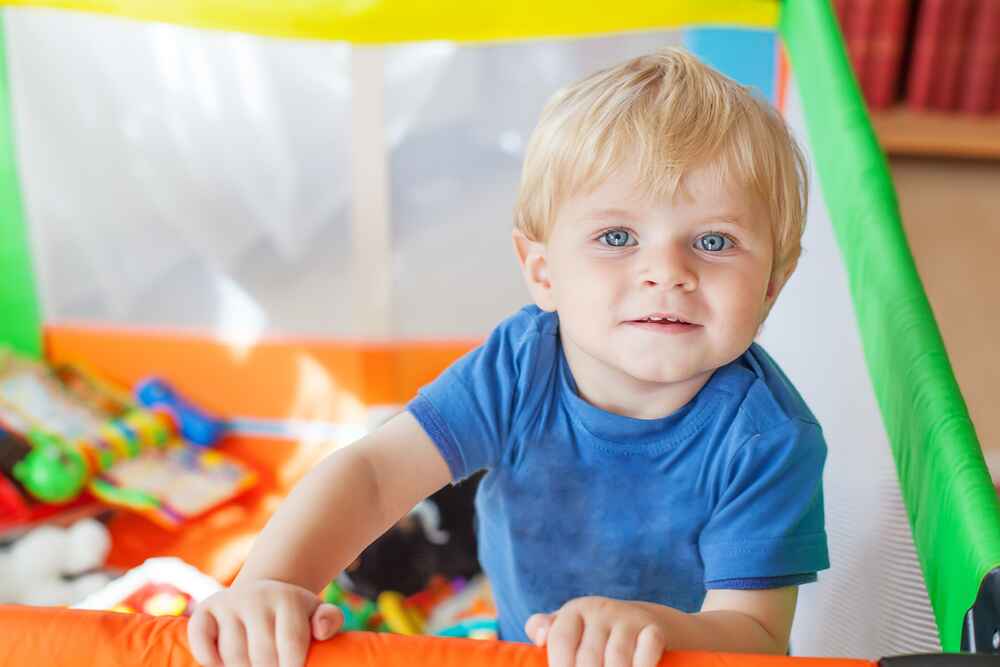
Safety Features: Look for the best play yards that meet safety standards and have features like sturdy construction, non-toxic materials, secure locking mechanisms, and mesh panels that provide good airflow and visibility.
Size and Configuration: For families with limited space or those who travel frequently, a compact, lightweight model may be ideal. Conversely, larger playpens can offer more space for play and may include additional features such as integrated toys or activity centers. Some playpens are adjustable or modular, allowing you to customize the size and shape to fit your space.
Ease of Cleaning: Opt for baby fences with removable, machine-washable fabric or easy-to-clean surfaces for quick and hassle-free cleaning.
Stability: Check the stability of the playpen, ensuring it has sturdy legs and a stable base to prevent tipping or wobbling, especially if your baby is active and may try to climb or pull on the sides.
Versatility: Consider whether you want a playpen with additional features such as a bassinet attachment, a changing station, storage poc
Tips for Using Baby Playpens Effectively
1. Regularly Rotate Toys: Keep your baby engaged by rotating the toys and activities available in the playpen. This prevents boredom and stimulates their curiosity and development.
2. Encourage Exploration: Include toys with different textures, colors, and sounds to stimulate their senses and encourage exploration.
3. Create a Comfortable Environment: Use a soft mat or padding on the floor to provide a cushioned surface for your baby to sit and play on.
4. Establish a Routine: Incorporate playpen time into your baby’s daily routine to help them become familiar with the space and develop a sense of routine and structure.
5. Use Playpen for Short Periods: While playpens are useful for providing a safe space for your baby to play, it’s essential to balance playpen time with other activities and interactions throughout the day. Limit playpen sessions to short periods to prevent your baby from becoming overly reliant on it for entertainment.
6. Promote Independence: Encourage your baby to explore and play independently within the playpen. This helps foster their sense of independence and self-confidence as they learn to entertain themselves.
7. Offer Support and Interaction: Engage with your baby while they are in the playpen by talking, singing, and playing with them.
FAQ
Q: How do I set up a baby playpen?
A: Setting up a baby playpen typically involves unfolding the frame, securing any locking mechanisms, and adding any desired accessories or toys. Follow the manufacturer’s instructions carefully to ensure proper assembly and safety.
Q: How Long Can a Baby Stay in a Playpen?
A: The duration a baby can stay in a playpen varies depending on their age, mobility, and level of contentment. It’s important to monitor the baby for signs of restlessness or discomfort and to balance playpen time with other activities and interactions.
Q: How can I prevent my child from climbing out of the playpen?
A: To prevent your child from climbing out of the playpen, choose a playpen with high sides or mesh panels that are difficult to climb, remove any objects or toys that could be used for climbing, and supervise your child closely while they are in the playpen.
Q: Can Playpens Be Used Outdoors?
A: Many playpens are designed for both indoor and outdoor use, featuring durable materials and UV protection. However, ensure the playpen is placed on a stable surface and in a shaded area to protect the baby from direct sunlight and heat.
Q: Are there any alternatives to baby playpens?
A: Yes, alternatives to baby playpens include using baby gates to create a safe play area in a room, using a large blanket or mat on the floor for supervised play, or baby-wearing to keep your child close while you move around the house.
Conclusion
Baby playpens provide children with a safe place to rest and play, and are baby furniture worth investing in as they grow up. By understanding the above knowledge about baby playpens, parents can introduce them into their children’s daily lives and use and maintain them correctly.
How Can Clafbebe as a Baby Playpen Manufacturer Help You?
Clafbebe is a top baby playpen manufacturer in China, wholesale and exporting the best quality baby playpen products to many countries around the world. We have 5 production bases, nearly 12,000 square meters of factory buildings, and more than 200 employees.
We are confident in our strength and can provide the best quality and most satisfactory products to various wholesalers and retailers.
By cooperating with us, you will get:
- High-quality products: Clafbebe uses only the finest raw materials. Products are designed to exceed safety standards, ensuring peace of mind for parents and caregivers.
- Competitive pricing: Clafbebe aims to offer high-quality products at competitive prices, making it easier for retailers to attract customers without sacrificing quality.
- Support and collaboration: Clafbebe offers excellent customer support to resolve queries and assist with order placement.
Recommended Related Articles:


